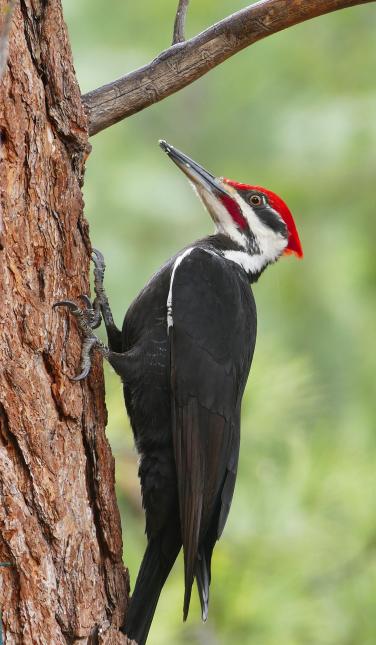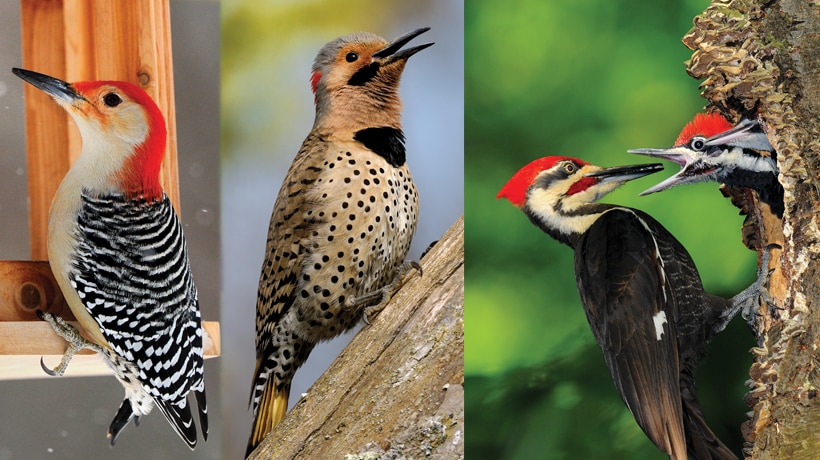Woodpeckers Unleashed: Discovering the Wonders of These Experienced Tree Mountain Climbers
Woodpeckers, with their unique markings and rhythmic drumming resembling with wooded locations, hold a special location in the bird globe. Their specialized makeup and adaptations enable them to navigate vertical surfaces with unrivaled ability. Nevertheless, their mastery of tree climbing is simply one element of their remarkable behavior. As we explore the intricate information of woodpeckers' nesting habits, feeding methods, and the ongoing preservation initiatives to safeguard these remarkable birds, a deeper admiration for their area in nature unravels.
Anatomy and Adaptations
When analyzing the composition and adjustments of woodpeckers, one can observe remarkable functions that make it possible for these birds to grow in their specialized eco-friendly particular niche. Furthermore, woodpeckers have zygodactyl feet, with two toes facing ahead and two facing in reverse, providing a company hold on tree trunks while they look for food or drum for interaction.
Additionally, woodpeckers have a special tongue framework that is long, barbed, and sticky, allowing them to draw out bugs from holes in wood. This specific adjustment allows woodpeckers to exploit a food source that is inaccessible to lots of other bird varieties. Generally, the anatomy and adjustments of woodpeckers showcase the remarkable transformative solutions that have actually allowed these birds to flourish in their arboreal environment.
Drumming Habits
Having discovered the makeup and adjustments of woodpeckers, the focus now changes to comprehending their drumming habits, an unique facet of their communication and territorial screens. Drumming is a crucial kind of communication amongst woodpeckers, serving several purposes such as establishing regions, drawing in companions, and signaling alarm system. Each woodpecker types has a distinct drumming pattern that helps individuals identify members of their very own types and identify them from competitors or killers.
Woodpeckers produce drumming noises by quickly pecking on powerful surface areas such as dead trees, energy poles, or also steel things, creating a collection of balanced beats. The strength and speed of drumming can vary based upon the objective; for example, a fast drumming series might indicate hostility in the direction of burglars, while a slower and softer drumming pattern could suggest courtship (Woodpeckers in Florida). In addition, woodpeckers might adjust the regularity and duration of their drumming to share specific messages efficiently
Nesting Behaviors
Checking out the nesting behaviors of woodpeckers discloses fascinating understandings right into their reproductive actions and habitat selections. Woodpeckers are recognized for their unique nesting preferences, frequently digging deep into cavities in trees to produce sheltered areas for elevating their young. These cavities serve not only click for more as a nesting site but also as a protected haven from predators and severe weather.
Woodpeckers display a high level of integrity to their nesting websites, usually going back to the same location time after time. This behavior highlights the significance of suitable habitat schedule for their reproductive success. The selection of a nesting website is crucial for woodpeckers, with factors such as tree species, height, and decay phase playing considerable duties in their decision-making process.
Remarkably, some woodpecker varieties are understood to excavate numerous dental caries within their area, supplying themselves with different nesting alternatives. This method may act as a form of insurance against potential hazards or disruptions to their key nesting site.

Feeding Techniques
One of the most distinct feeding habits of woodpeckers is drumming, which includes fast pecking on trees to discover bugs under the bark. Woodpeckers are likewise recognized to excavate tooth cavities in trees to access covert insect larvae or sap. Some varieties, like the acorn woodpecker, shop nuts in specifically created holes pop over to this site called granaries.
Preservation Initiatives
Among the intricate feeding strategies exhibited by woodpeckers, the conservation efforts targeted at guarding these fascinating birds play an important duty in preserving their environments and populaces. Woodpeckers face different hazards to their survival, including habitat loss due to deforestation, climate modification modifying their ecosystems, and accidents with synthetic frameworks such as buildings and vehicles - Woodpeckers in Florida. Conservationists are proactively functioning to resolve these difficulties and guarantee the lasting wellness of woodpecker types

Education and learning and public awareness campaigns are likewise crucial components of woodpecker conservation initiatives. By elevating recognition regarding the significance of these birds in preserving healthy and balanced forest ecological communities, guardians can gather support for environment preservation efforts and promote responsible land monitoring techniques. Via joint initiatives in between researchers, policymakers, and local communities, we can collaborate to secure a future where woodpeckers thrive in their natural habitats.
Final Thought
